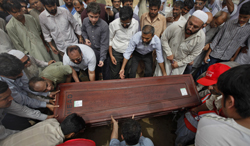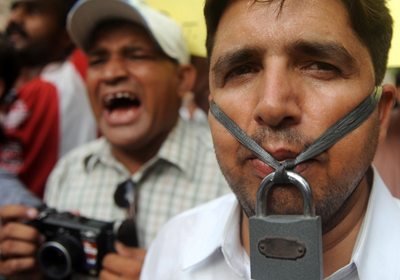For the past several weeks, CPJ’s Asia and Journalist Assistance programs have been in regular contact with local and international organizations who are concerned about the rising number of journalists and media workers at risk in Pakistan. CPJ and several other groups are working together on viable, in-country solutions: Journalists in Pakistan are in need of trauma counseling, urgent relocation, or support so that they may remain in hiding and avoid threats or physical attacks.
Pakistani journalists have faced threats, abduction, assault, censorship, displacement, torture, and murder in increasing numbers in recent years, CPJ research shows. One of the most alarming cases was the September 2010 attack on columnist Umar Cheema, who had reported critically on civilian and military authorities. Cheema was abducted, tortured, and then dumped with a warning: “If you tell the media about this, you’ll be abducted again–and won’t ever be returned.”
If you cover politics, corruption, or war, you’re more likely than any of your colleagues to be victimized at the hands of the military or paramilitary or intelligence groups. You may also become a victim of one of the two sides of Baluchistan‘s escalating ethnic strife, or of militants operating in the Federally Administered Tribal Areas, or of political factions, criminal groups, or feudal leaders vying for power. If threats and harassment don’t force you to quit journalism, then perhaps you’ll flee your home. If this fails, you may be killed. And if you’re killed in the line of duty, it is likely that those who perpetrated the crime will walk away, given Pakistan’s near–perfect level of impunity.
CPJ research shows that at least 39 journalists have been killed in direct relation to their work since 1992, with the fatality rate increasing dramatically in the past five years. Last year, CPJ ranked Pakistan the deadliest country for journalists in the world, with nine media deaths. Print journalists have suffered the highest loss, but broadcast journalists are not lagging far behind. The majority of victims, 95 percent, are local journalists, a pattern seen around the world.

With five journalists killed so far this year, 2011 seems set to be another deadly year for Pakistan’s press. Three of those five deaths were targeted killings. Geo TV’s Wali Khan Babar was gunned down after his story aired on gang violence in Karachi. Babar had been threatened in the past, according to CPJ research. On World Press Freedom Day (May 3), Pakistan’s President Asif Ali Zardari told a CPJ delegation that he would pursue justice for all journalists killed on the job. A week later, reporter Nasrullah Afridi from the northwestern Khyber Agency died when his car exploded in Peshawar. According to the Pakistan Federal Union of Journalists, Afridi was in Peshawar fleeing threats from militant groups. And then Saleem Shahzad‘s tortured body was found on May 31. He had been abducted and murdered after reporting on ties between Al-Qaeda and Pakistan’s navy, news reports said. For months, the reporter had been telling friends that he had been warned by intelligence agents to stop reporting on sensitive security matters. In late June, a government-established commission was formed to look into the Shahzad killing.
On August 5, Asia Program Coordinator Bob Dietz and I wrote a blog post headlined Quantifying the threat to journalists in Pakistan, which began: “For many journalists working in Pakistan, death threats and menacing messages are simply seen as part of their job.” But now the real question seems to be whether the threat of death–either from a targeted killing or being caught in the country’s mounting violence–has become a routine part of working as a journalist in Pakistan.
